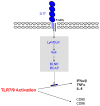Signaling and ligand interaction of ILT7: receptor-mediated regulatory mechanisms for plasmacytoid dendritic cells
- PMID: 20193018
- PMCID: PMC2919054
- DOI: 10.1111/j.0105-2896.2009.00867.x
Signaling and ligand interaction of ILT7: receptor-mediated regulatory mechanisms for plasmacytoid dendritic cells
Abstract
Plasmacytoid dendritic cells (pDCs) are specialized dendritic cells (DCs) that produce large amounts of type I interferon (IFN) after Toll-like receptor (TLR) activation. Human pDCs preferentially express immunoglobulin-like transcript 7 (ILT7; LILRA4), which couples with a signaling adapter to activate a prominent immunoreceptor tyrosine-based activation motif (ITAM)-mediated signaling pathway. ILT7 protein directly binds to and can be activated by bone marrow stromal cell antigen 2 (BST2; CD317) protein, the expression of which is found on cells pre-exposed to IFN or on the surface of human cancer cells. The interaction between ILT7 and BST2 functions to assure an appropriate TLR response by pDCs during viral infection and likely participates in pDC-tumor crosstalk. Two opposing modes of receptor-mediated regulatory mechanisms work jointly to fine tune the innate immunity of pDCs.
Figures



Similar articles
-
Regulation of TLR7/9 responses in plasmacytoid dendritic cells by BST2 and ILT7 receptor interaction.J Exp Med. 2009 Jul 6;206(7):1603-14. doi: 10.1084/jem.20090547. Epub 2009 Jun 29. J Exp Med. 2009. PMID: 19564354 Free PMC article.
-
Plasmacytoids dendritic cells are a therapeutic target in anticancer immunity.Biochim Biophys Acta. 2012 Dec;1826(2):407-14. doi: 10.1016/j.bbcan.2012.04.007. Epub 2012 May 9. Biochim Biophys Acta. 2012. PMID: 22579960 Review.
-
Activation of the ILT7 receptor and plasmacytoid dendritic cell responses are governed by structurally-distinct BST2 determinants.J Biol Chem. 2019 Jul 5;294(27):10503-10518. doi: 10.1074/jbc.RA119.008481. Epub 2019 May 22. J Biol Chem. 2019. PMID: 31118237 Free PMC article.
-
Unraveling the functions of plasmacytoid dendritic cells during viral infections, autoimmunity, and tolerance.Immunol Rev. 2010 Mar;234(1):142-62. doi: 10.1111/j.0105-2896.2009.00881.x. Immunol Rev. 2010. PMID: 20193017 Free PMC article. Review.
-
Ig-like transcript 7, but not bone marrow stromal cell antigen 2 (also known as HM1.24, tetherin, or CD317), modulates plasmacytoid dendritic cell function in primary human blood leukocytes.J Immunol. 2013 Mar 15;190(6):2622-30. doi: 10.4049/jimmunol.1202391. Epub 2013 Feb 11. J Immunol. 2013. PMID: 23401591 Free PMC article.
Cited by
-
Inhibitory receptors of plasmacytoid dendritic cells as possible targets for checkpoint blockade in cancer.Front Immunol. 2024 Mar 5;15:1360291. doi: 10.3389/fimmu.2024.1360291. eCollection 2024. Front Immunol. 2024. PMID: 38504978 Free PMC article. Review.
-
Tolerogenic plasmacytoid DC.Eur J Immunol. 2010 Oct;40(10):2667-76. doi: 10.1002/eji.201040839. Eur J Immunol. 2010. PMID: 20821731 Free PMC article. Review.
-
Control of lupus activity during pregnancy via the engagement of IgG sialylation: novel crosstalk between IgG sialylation and pDC functions.Front Med. 2023 Jun;17(3):549-561. doi: 10.1007/s11684-022-0965-7. Epub 2023 Apr 3. Front Med. 2023. PMID: 37010728
-
The plasmacytoid dendritic cell as the Swiss army knife of the immune system: molecular regulation of its multifaceted functions.J Immunol. 2014 Dec 15;193(12):5772-8. doi: 10.4049/jimmunol.1401541. J Immunol. 2014. PMID: 25480956 Free PMC article. Review.
-
Human CD34+-derived plasmacytoid dendritic cells as surrogates for primary pDCs and potential cancer immunotherapy.Front Immunol. 2024 Nov 7;15:1433119. doi: 10.3389/fimmu.2024.1433119. eCollection 2024. Front Immunol. 2024. PMID: 39575246 Free PMC article.
References
-
- Steinman RM, Banchereau J. Taking dendritic cells into medicine. Nature. 2007;449:419–426. - PubMed
-
- Steinman RM. Dendritic cells: versatile controllers of the immune system. Nat Med. 2007;13:1155–1159. - PubMed
-
- Banchereau J, Steinman RM. Dendritic cells and the control of immunity. Nature. 1998;392:245–252. - PubMed
-
- Colonna M, Trinchieri G, Liu YJ. Plasmacytoid dendritic cells in immunity. Nat Immunol. 2004;5:1219–1226. - PubMed
Publication types
MeSH terms
Substances
Grants and funding
LinkOut - more resources
Full Text Sources
Other Literature Sources
Molecular Biology Databases

